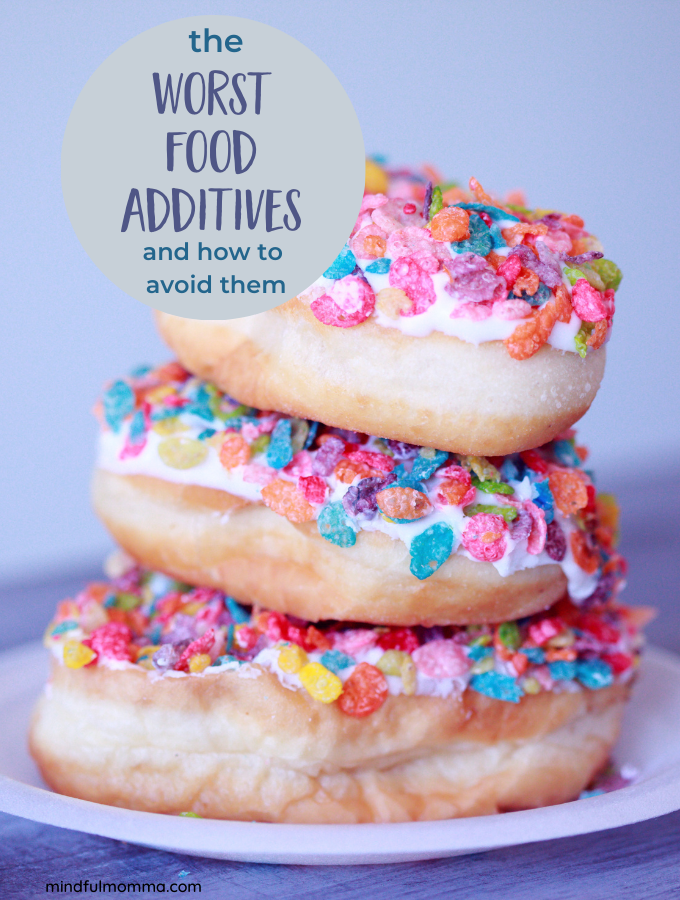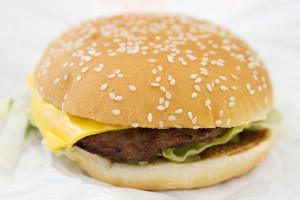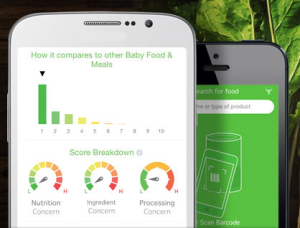The 12 Worst Food Additives and How to Avoid Them
Learn where the worst food additives are hiding in food, how to avoid them and how to find healthy food instead.

Grocery shopping can be tricky business. Especially when you have family members to shop for, all with different taste preferences, allergies and dietary needs. We’ve been well-trained to look at the basic nutrition information on a product – calories, fat, sugar, protein etc… – but one thing that we often overlook, even when we are shopping for healthy food, is additives.
Typically near the bottom of the ingredients label, additives show up as unpronounceable chemical names or seemingly innocuous words like flavor and color. But their relative stature on the ingredients list does not mean they should be ignored. Many food additives are linked to adverse health effects like cancer and hormonal imbalances.
At Mindful Momma we only endorse products we’ve personally researched, tested, and honestly love. We may receive commissions from affiliate links in this article including Amazon Affiliates. Full Disclosure
The Worst Food Additives – EWG’s Dirty Dozen
To help people like us out, the Environmental Working Group (EWG) developed a dirty dozen guide to the worst food additives. Use it to make smarter food choices for you and your loved ones.
Nitrites and Nitrates
Preservatives found in cured meats like salami, bacon and ham that react to form cancer-causing nitrosamines.
Potassium Bromate
Known carcinogen used to strengthen bread and cracker dough and help the rising process.
Propyl Paraben
Endocrine disrupting chemical used as a preservative in tortillas, muffins and food dyes.
Butylated Hydroxyanisole (BHA)
Classified as an endocrine disruptor by the European Union but used as a preservative in chips and other foods that contain fats and preserved meats.
RELATED: 4 Reasons to Buy Natural, Non-Toxic Products for Your Family
 Butylated Hydroxytoluene (BHT)
Butylated Hydroxytoluene (BHT)
Preservative that has been associated with cancer and endocrine disruption. Found in cereals, breads, crackers and snack foods.
Propyl Gallate
Used to preserve products that contain fats like sausage, pepperoni and lard. Associated with tumors and estrogenic activity.
Theobromine
An alkaloid with similar effects to caffeine, found in bread, cereals and sports drinks. Never proven safe but made it through an FDA loophole.
Flavor Ingredients
An unregulated mixture of ingredients that can contain synthetic chemicals, solvents and preservatives. Found in anything labeled with the word flavor or flavoring. Even so-called “natural flavors” can actually contain synthetic chemicals such as the solvent propylene glycol or the preservative BHA. Flavor extracts and ingredients derived from genetically engineered crops may also be labeled “natural”.
 Artificial Colors
Artificial Colors
Includes synthetic FD&C colors (linked to hyperactivity and attention issues in kids) and Caramel colors III and IV (cancer concern). Found in many products to increase visual appeal.
Diacetyl
Flavor chemical found in microwave popcorn and dairy products as well as “brown flavorings” like butterscotch and maple or “fruit flavorings” like strawberry and raspberry. Linked to respiratory disease, especially in factory workers.
Phosphate Food Additives
Used to leaven baked goods, reduce acid and improve moisture retention and tenderness in processed meats. Found in many fast food products. Association with cardiovascular problems.
Aluminum Additives
Used as a stabilizer in many processed foods. Association with neurotoxicity and Alzheimer’s disease.
How to Avoid the Worst Food Additives
Read labels – Be diligent about label reading and avoid processed foods that contain these additives.
Use EWG’s Food Scores database – This is a great resource for researching food products you already buy or might buy. Products are rated by nutrition, ingredient and processing concerns. The Food Scores database is available online or use the app for iPhone or Android when you are on-the-go.
Buy healthy foods – Avoid highly processed foods in general and cook whole, real foods as much as possible. When you do purchase pre-made foods, look for fresher options like fresh bread and bakery products, and foods without the worst additives like nitrate-free meats from ButcherBox or breakfast cereal without artificial colors and flavors. Even treats and snack food can be better (although it’s never healthy) – so look for organic snacks or candy made with natural colors and flavors.
Shop at natural food stores – When you shop at a store that specializes in healthy, natural food, you won’t be tempted by unhealthy products. Whole Foods or your local food coop are great places to shop for healthy food. My favorite place to buy healthy groceries online is Thrive Market because they have so many of my favorite foods. I use Thrive Market to keep my healthy pantry stocked at all times!
Petition food companies – Keep an eye out on Change.org and TakePart for petitions related to food additives and sign them. The Food Babe petitioned Kraft to take food dyes out of mac & cheese and they did it (on 3 products only). Better yet, start your own petition!
Donate to EWG – Help the EWG keep up the good work by giving them a tax-deductible donation.
Which of these worst food additives concern you most?







Great article. I wasn’t aware of EWG’s food additive guide. I spend most of my time in grocery stores just looking at the labels. Sometimes I wonder where the “food” is.
Ha! Good point Anna. There’s a lot of stuff in the grocery store that shouldn’t be called food but is.
These are on my list of things I avoid even when I “cheat” on my normal whole food diet. I love EWG’s guides like these, they are great for people just switching to whole foods or those that can’t for whatever reason, buy all whole foods.
We are lucky to have organizations like EWG to help us (obviously the government isn’t)!
It frustrates me to see so many chemicals and crap in our food! No wonder people are getting so sick 🙁
I agree Julie! Let’s hope better chemical regulations are passed soon!
Thanks for this helpful list. I was happy to see that none of the ingredients listed are in my favorite food brand, Wildtree.
Such a relief, right?
You could also buy local food from the people who make it :). Or even grow/make your own.
Of course that’s a wonderful option for when you can do it!